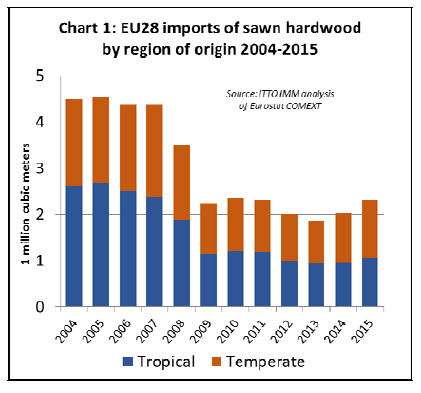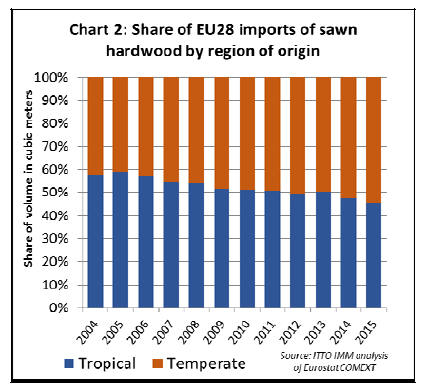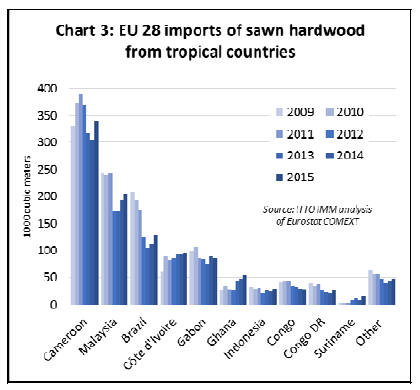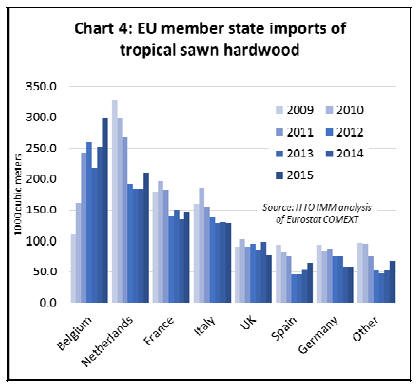|
Report from
Europe
EU tropical sawn hardwood imports rose 9% in 2015
In 2015, EU imports of tropical sawn hardwood were 1.05
million cu.m, 9% more than previous year. The value of
EU imports increased by 15% to Euro772 million.
The average unit value of tropical sawn hardwood imports
into the EU in 2015 was Euro732 per cubic meter, up from
Euro670 per cubic meter the previous year, the increase
due to the euro being on average 20% weaker against the
US$ in 2015 compared to 2014.
While the rise in EU imports of tropical sawn hardwood in
2015 is encouraging, the volume of imports remains at
historically very low levels. Import volume in 2015 was
only 40% of the level prevailing before the global
financial crises and fell short even of the level between
2009 and 2011 in the immediate aftermath of the crises
(Chart 1).

The pace of increase in import volume in 2015 was also
slower than for temperate sawn hardwoods which jumped
19% to 1.26 million cu.m. The share of tropical in total
EU sawn hardwood imports fell from 48% in 2014 to 46%
in 2015, continuing a long term trend (Chart 2).

On the other hand, the loss of tropical wood*s share in EU
sawn hardwood imports is less obvious in euro value
terms; tropical wood*s share was 57% in 2015, the same as
the previous year and not too far short of the level of 62%
that prevailed before the global financial crises.
Main tropical producer countries extend their market
dominance
Cameroon, Malaysia, and Brazil, Europe*s top three
suppliers of sawn tropical hardwood, each recorded
significant growth in deliveries to the EU last year (Chart
3).

Cameroon was by far the largest single supplier of tropical
sawn hardwood to the EU in 2015, accounting for almost
one-third of all imports. EU imports from Cameroon were
339,000 cu.m last year, 12% more than in 2014.
There was solid growth in sales of Cameroon sawn
hardwood to several EU markets in 2015 including France,
Belgium, Spain, and Italy. These gains were sufficient to
offset a decline in sales to the Netherlands, Germany and
the UK.
EU imports from Malaysia were up 7% to 206,000cu.m in
2015, the rise being entirely due to much higher imports
by the Netherlands (although the data here is highly
uncertain 每 see next section). Most other EU countries
recorded low or declining sawn hardwood imports from
Malaysia last year.
European imports of sawn tropical wood from Brazil
increased 14% to 128,000 cu.m in 2015. The main driving
forces behind this increase were France, Belgium and, to a
lesser extent, Germany.
Of other significant producer countries, there was doubledigit
growth in tropical sawn hardwood imports into the
EU in 2015 from Ghana (+15% to 55,000 cu.m), Indonesia
(+22% to 29,000 cu.m), and the Democratic Republic of
the Congo (+27% to 26,000 cu.m). However EU imports
from Gabon fell 5% to 85,000 cu.m and imports from
Congo declined 4% to 28,000cu.m.
Tropical wood imports recover in France and Benelux
countries
The rise in EU tropical sawn hardwood imports was owing
to recovery of demand in the three largest importing
markets: Belgium (+19% to 299,100 cu.m), Netherlands
(+14% to 210,700 cu.m) and France (+10% to
147,800cu.m). Together these three markets accounted for
62% of the EU*s tropical sawn hardwood imports in 2015
(Chart 4).

By far Belgium*s largest supplier of tropical sawn
hardwood is Cameroon, from where the country imported
124,500 cu.m last year, 22% more than in 2014 and 304%
more than in the crisis year of 2009.
Belgian imports from Gabon have also grown dramatically
in the last six years, from just 3,800 cu.m in 2009 to
53,800 cu.m in 2015. As early as 2011, Gabon ousted
Malaysia as Belgium*s second most important supplier of
tropical sawn hardwood. Malaysia is the only one among
the seven top suppliers to have delivered less sawn timber
to Belgium in 2015 than in 2009.
Data on sawn hardwood volume imports provided by the
Netherlands authorities to Eurostat is inconsistent and
difficult to interpret. The data shown here has been heavily
amended, based on (simplistic) assumptions that import
value recorded by the Dutch authorities is accurate and
unit values are likely to have remained reasonably
consistent. The adjusted Netherlands data suggests a rise
in tropical sawn hardwood imports in 2015, largely driven
by increased trade with Malaysia.
There are reasons to believe that there might have been an
increase in Netherlands imports from Malaysia in 2015.
After several very depressed years, the Dutch construction
sector is growing again. Meanwhile the Dutch government
in 2014 finally recognised the Malaysian Timber
Certification System (MTCS) as meeting their criteria for
sustainable timber after many years of effort by the MTCS
and Malaysian Timber Council.
This at a time when the Netherlands timber trade has made
very far-reaching commitments to procurement of only
certified timber products in recent years, claiming that
74% of all wood imported into the country is certified. The
Dutch EUTR enforcement regime also appears to be
relatively more rigorous than in some other EU countries.
In short, all these factors may have encouraged Dutch
importers to buy more Malaysian timber at the expense of
imports from other tropical countries less capable of
delivering certified product.
It*s notable that the recent apparent rise in Dutch imports
of Malaysian sawn timber has been matched by a decline
in imports from Cameroon.
However these comments in relation to the Netherlands
are still speculative. The Malaysian export data, which
seems more consistent than the Dutch import data,
recorded no increase in exports of sawn hardwood to the
Netherlands in 2015.
Imports of tropical sawn hardwood into France increased
9.7% to 147,800 cu.m in 2015. As in the Netherlands,
there were signs of improving economic performance in
France in 2015. Important market players in the French
tropical timber sector, such as the tropical sawn hardwood,
logs and plywood producer Rougier, reported improving
demand, although still in a very competitive environment.
Cameroon and Brazil were the primary beneficiaries of the
rise in French imports of sawn tropical hardwood last year.
Imports from Cameroon jumped 48.9% to 46,100 cu.m,,
cementing the country*s position as France*s leading
supplier. French imports from Brazil increased 29.1% to
36,400 cu.m but are still far below the volume of 61,100
cu.m delivered by Brazil in 2009.
The Italian market for tropical sawn hardwood is still in
the doldrums. Italian wood importers had started to be a
little more optimistic again in 2014, but this trend did not
last.
After a 2% rise in 2014, the first increase since 2010,
imports fell back again last year by 1% to 129,000cu.m.
The share of tropical in Italy*s total imports of sawn
hardwood fell from 21% to 18%. This was mainly due a
significant rise in Italian imports from other EU countries,
a development partly due to the fashion for oak in
furniture production. Also, due to the weakness of the
euro, beech and other pale European hardwoods are likely
being used for mouldings in place of tropical wood and
American tulipwood (imports of which also declined in
2015).
Italy*s imports of tropical sawn hardwood increased from
both leading supply countries in 2015. Imports were up
9.5% from Cameroon to 61,200 cu.m and 6.2% from Côte
d*Ivoire to 26,500 cu.m. However these gains were offset
by a sharp fall in imports from Gabon, the third most
important supplier, down 29% at 23,200cu.m.
After rising in 2014, UK imports of tropical sawn
hardwood fell 23% to 76,500 cu.m in 2015. Total UK
imports of sawn hardwood, both temperate and tropical,
declined 7.6% to 428,000cu.m in 2015. The share of
tropical countries in total UK sawn hardwood imports fell
from 22% in 2014 to 18% in 2015. Cameroon replaced
Malaysia as the UK*s largest supplier of tropical sawn
hardwood in 2010 and maintained this position until 2014.
However, last year imports from Cameroon fell by 41.4%
to 20,800 cu.m. In 2015, Malaysia overtook Cameroon to
become the largest tropical sawn hardwood supplier to the
UK despite a 17.5% decline in imports to 20,900cu.m.
The rebound in Spain*s imports of tropical sawn hardwood
continued last year, with imports rising 19% to 64,400
cu.m. This follows a similar gain in imports in 2014 and
suggests the recovery in Spain*s crisis-stricken market is
becoming more sustainable.
Tropical wood also seems to be maintaining market share
in Spain: in 2015 sawn hardwood from tropical countries
accounted for 40% of total sawn hardwood imports up
from 39% in 2009. Spain imports tropical timber primarily
from Cameroon and Brazil, both of which showed growth
last year, by 25.2% to 38,400cu.m and 26.9% to
10,700cu.m, respectively.
USA, the largest sawn hardwood supplier to the EU
The USA remained the single largest external supplier of
sawn hardwood into the EU in 2015, but deliveries fell by
6% to 366,000 cu.m. At the same time, the EU*s sawn
hardwood imports from Canada fell by 23% to 24,000
cu.m.
Data compiled by the American Hardwood Export Council
(AHEC) indicates that exports of U.S. sawn hardwood to
the EU fell 11% in volume and 10% in dollar value last
year. While exports of white oak and red oak increased
slightly, there was a significant fall in exports of other
U.S. hardwood species, particularly tulipwood and ash.
According to AHEC, ※these declines occurred at a time
when European currencies weakened sharply against the
dollar and there was only slow post-recession growth in
key economic sectors, like construction and furniture§.
AHEC also note that concerns about future supplies of ash
due to the Emerald Ash Borer, combined with uncertainty
over EU rules for phytosanitary certification of American
ash may have encouraged manufacturers to build up stock
during 2014.
This combined with the weakening euro led to the sharp
fall in exports of ash during 2015. American ash is now
subject to very stringent phyto-sanitary requirements in the
EU (AHEC argues too stringent) which is severely
limiting opportunities for export of this species.
Increased EU imports of lower value Eastern European
hardwood
A key trend in the EU sawn hardwood trade in recent
years has been increased dependence on imports of lower
value product from Eastern Europe, notably Ukraine,
Belarus, Russia, Bosnia and Serbia.
In 2015 there were higher deliveries from the Ukraine
(+37% to 350,000cu.m), Belarus (+63% to 128,000cu.m),
Russia (+117% to 125,000cu.m), Bosnia (+17% to
112,000 cu.m) and Serbia (+3% to 77,000 cu.m).
Growth in import volumes was significantly higher in each
case than the rise in euro-based import value, as all three
countries* currencies fell dramatically against the euro in
2015. This is likely to have a decisive factor for the sharp
rise in volumes from this region last year.
Much of the product arriving from Ukraine, Bosnia and
Serbia is oak which remains very fashionable in the EU
flooring and furniture sectors. Material from Belarus and
Russia is mainly lighter lower grade hardwoods such as
birch and aspen used for packaging and other industrial
uses.
To some extent the rise in imports from these Eastern
European countries is an inevitable result of the EU*s
manufacturing centre of gravity shifting from higher cost
countries in the west to lower cost countries in the east.
The latter are more inclined to source hardwood from
neighbouring non-EU countries than from tropical
countries or North America.
Regulatory changes may have been an additional factor in
the case of the Ukraine. In April 2015, the Ukrainian
government banned exports of logs for 10 years effective
from 1 November 2015. The log export ban affects logs
and poles as well as sawn wood with thickness exceeding
70 mm and over 22% moisture content. In addition to the
log export ban, Ukraine added oak to the list of ※rare and
valuable§ timber species for which controls are imposed
on a wider range of secondary and tertiary processed
products.
These various new regulations contributed to a significant
shift in the make-up of hardwood imports into the EU
from Ukraine during 2015. Ukrainian oak log deliveries to
the EU plummeted to 29,000 cu.m last year, down from
82,000 cu.m in 2014. Meanwhile EU imports of Ukrainian
sawn oak rose dramatically, probably a short-lived trend as
importers purchased additional supplies before November
2015 to beat the extra controls on oak which are now in
force.
Challenges remain despite rising tropical timber
imports
While imports have been rising and some key sectors of
the European economy, such as construction, furniture and
flooring, are now growing slowly, these remain
challenging times for the European hardwood industry.
Use of all hardwood in traditional applications in Europe,
but particularly for mass-produced goods like doors and
flooring, continues to come under pressure. Many
consumers are still cash-strapped and, while they want the
look of hardwood, they often won*t pay the price for what
is perceived to be a luxury product. Share continues to be
lost to alternative materials perceived to be cheaper and
easier to maintain. Alternatives include panel products like
MDF, softwood 每 sometimes chemically or thermally
modified or engineered - as well as laminates and plastics.
Challenges are particularly pronounced for tropical
hardwood. There is a persistent ※image problem§, while
the EU Timber Regulation together with uncertainty over
the legality of product seems to be limiting EU
procurement of tropical timber to a narrower range of
companies, both on the importing and exporting side.
Importers also continue to mention lack of supply
continuity, transport problems and long lead times as
factors impeding increased use of tropical timber in the
EU.
Tropical wood LCA performance beats other materials
Sustainably sourced tropical timber species out-performed
competitor materials in a demanding life cycle analysis
project backed by the European STTC. Eric de Munck of
Netherlands每based timber research body Centrum Hout
led the trials, which pitted tropical timbers against key
market rivals in the manufacture of marine application pile
planking and window frames.
The pile planking life cycle analysis (LCA) project was
proposed to the STTC by the Netherlands Timber Trade
Association (NTTA) and other industry players due to the
fact that tropical timber faces increasingly strong
competition in this market from steel, PVC, plus other
varieties of wood. The research team also said that
existing environmental data for the species used in this
application was out-dated and unreliable.
The study, undertaken in association with the FSC
Netherlands, has already generated impressive figures in
favour of tropical timber in terms of cradle to grave
environmental cost per square metre.
The species used were sustainably sourced African azob谷
and okan and South American angelim vermelho. They
were evaluated against two types of PVC planking 每 one
comprising all virgin raw material, the other recycled 每
and steel.
The researchers chose a popular form of pile planking and
applied equivalent LCA methods to all materials types.
Preliminary results showed that, over a 30-year lifespan,
the environmental performance of tropical timber planking
is 24 times better than virgin-material PVC and 21 times
better than recycled. Compared to steel it*s 133 times
better.
The final LCA data from the research will be added to the
Dutch Environmental Database and international data
resources Ecoinvent and ILCD (the International
Reference Life Cycle database). The results will also be
publicised via the trade media, presentations to industry
events and direct to tropical timber end users and
specifiers.
The window frame LCA, which is being undertaken in
association with the Netherlands Woodworking Industry
Association, is using sustainably sourced African, Asian
and South American reference wood species.
The competitor materials in this case are softwood,
modified softwood and PVC and initial results are
expected by the end of next March. Both studies will be
completed and implemented by the end of next June, with
the outcomes widely publicised.
STTC gains momentum and puts money on the table
But the news is not all bad. There is a growing coalition of
companies and other organisations in the EU committed to
making the case for a long-term trade in tropical
hardwoods in the EU 每 although with the important
qualification that all tropical wood promoted for use in the
EU should be either third party certified or, at minimum,
subject to independent legality verification. That of course
raises questions, still not satisfactorily addressed, about
equitable market access, particularly for community and
other non-industrial forest operators.
The FLEGT Action Plan and associated work through
Voluntary Partnership Agreements (VPAs) with most of
the leading tropical wood suppliers to the EU is beginning
to encourage the development of more enlightened policy
environment and positive image for tropical wood
products in the EU.
Meanwhile there are signs that the European Sustainable
Tropical Timber Coalition (STTC), which started in 2013,
is gaining momentum. The STTC brings together
companies in timber sector, retail, and end-use industries,
with government officials and NGOs in the interests of
promoting increased use of certified tropical timber in the
EU. STTC has established a target to increase EU sales of
certified tropical timber by 50% over 2013 levels by 2020.
In March STTC launched a new phase of development
involving a closer strategic partnership with the European
Timber Trade Federation (ETTF), re-energised
communications and membership drives and, critically, a
funding initiative to back private and public sector Action
Plans and projects.
Timber businesses can now receive match-funding for
activities in the framework of an STTC Action Plan for up
to 30% of the cost, or Euro15,000. Federations are eligible
for grants of up to Euro30,000 for developing sustainable
sourcing policies. In addition, STTC partners and
participants can submit project proposals with a requested
STTC contribution up to Euro50,000 if it contributes to
STTC objectives.
A new website (www.europeansttc.com) lays out STTC
goals and the all-round case for using sustainable tropical
timber. It provides technical data, tropical timber
application case studies, lists STTC partners and members
and explains how to join and apply for funding.
ATIBT, PEFC and STTC link up to promote tropical
timber
Also in March, STTC acquired two influential new
partners with potentially important implications for the
future scope, direction and level of support for STTC
activities. One new STTC partner is the International
Tropical Timber Technical Association (ATIBT), which
supports development of international trade in tropical
timber, both as a viable business, and a means of helping
maintain the tropical forest and the habitats and
biodiversity it supports.
On announcing the partnership, ATIBT President Robert
Hunink emphasised the important role of STTC to
encourage introduction and promotion of so-called &lesser
used species*, noting that ※successful promotion of these
species is especially crucial for the economic viability of
operators in the Congo Basin and to maintain a balanced
species composition in the forest.§
PEFC is the other new STTC member and is already in
discussion with STTC about a project which aims to
increase European imports of certified tropical timber
from Asia, now one of PEFC*s principal focus areas. The
specific objective of the joint project is to create improved
linkages between growing certified Asian timber output
and the EU market and to address critical bottlenecks in
supply of certified wood products from the region.
|